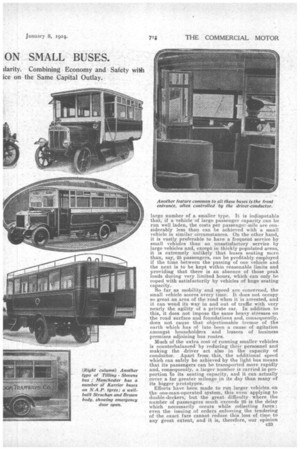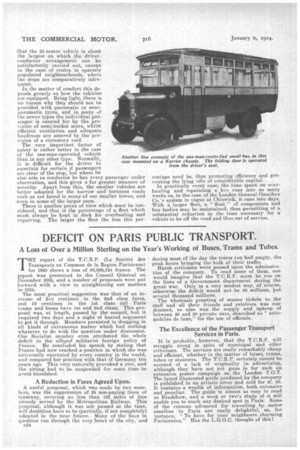STAFF REQUIREME ON SMALL BUSES.
Page 16

Page 17

Page 18

If you've noticed an error in this article please click here to report it so we can fix it.
T. THOSE who are fully acquainted with the march of events in the commercial-vehicle industry, oneof the most surprising factors which have to be considered is the tremendous progress made in the development of the small bus, and particularly in that type known as " one-man-operated." The majority of the smaller towns, and even some of those of considerable size, are adopting this type of vehicle, apparently in preference to any other.
In general design the vehicles employed closely resemble each other, differing only in detail. There is the single entrance of convenient width at the near-side front, or, in other words, at the left of the driver's seat, so arranged that to obtain access to, or exit from, the interior of the vehicle, passengers must pass close to the driver conductor, who is thusable to take their fares and to check where the passengers alight without leaving his seat. In some instances the door is hinged in the centre as well as at the side and can be controlled from the driver's seat by a special systam of levers. A self-closing, vertical, roller-blind-type door has also been tried.
In the Vulcan bus the act of closing the door also folds up the step, and thus children or passengers are prevented from standing on this step when the door is closed. .
In the vehicle itself the seats are usually arranged at each side of a gangway, being in rows of two at one side and in a single line at the other side. The majority of municipalities compel the provision of an emergency door at the rear, so that in case of accident or fire the passengers may make use of this door. To open it, it is usually necessary to lift up a folding seat and to operate a catch which is either concealed or to which access can be gained only by breaking some small portion of the door, so that there is no risk of the door being opened in error or wilfully, but solely in case of sheer necessity.
In certain types luggage rails are provided on the roof, but it is not always advantageous, for much time may be lost if the driver has to leave his seat in order to superintend the stowage of passengers' impedimenta.
Many smaller municipalities have had the option of purchasing a few large buses or a comparatively c32 large number of a smaller type. it is indisputable that, if a vehicle of large passenger capacity can be run well laden, the costs per passenger-mile are considerably less than can be achieved with a small
vehicle in similar circumstances. On the other hand, it is vastly preferable to have a frequent service by small vehicles than an unsatisfactory service by large vehicles and, except in thickly populated areas,it is extremely unlikely that buses seating more than say, 25 passengers, can be profitably employed if the time between the passing of one vehicle and the next is to be kept within reasonable limits and providing that there is an absence of those peak loads during very limited hours, which can only he coped with satisfactorily by vehicles of huge seating capacity.
So far as mobility and speed are concerned, the . small vehicle scores every time. It does not occupy so great an area of the road when it is arrested, and it can wend its way in and out of traffic with very nearly the agility of a private car. In addition to this, it does not impose the same heavy stresses on the road surface and foundations and, consequently, does not cause that objectionable .tremor of the earth which has of late been a cause of agitation amongst householders and lessees of business premises adjoining bus routes.
Much of the extra cost of running smaller vehicles
is counterbalanced" by reducing their personnel and making the driver act also in the capacity of conductor. Apart from this, the additional speed which can safely be achieved by the light bus means that its passengers can be transported more rapidly and, consequently, a larger number is carried in proportion to its seating capacity, and it can actually cover a far greater mileage in its day than many of its bigger prototypes.
Efforts have been made to run larger vehicles on
the one-man-operated system, this even applying to double-deckers, but the great difficulty where the number of passengers much exceeds 25 is the delay which necessarily occurs while collecting fares ; even the issuing of orders enforcing the tendering of the exact fare cannot reduce this loss of time to any great extent, and It is, therefore, our opinion
that the 25-seater vehicle is about the largest on which the • driverconductor arrangement can be satisfactorily carried out, except in the case of routes in sparsely populated neighbourhoods, where the stops aie comparatively infrequent..
In the matter of comfort this depends greatly on how the vehicles are equipped. Being light, there is no reason why they should not be provided. with pneumatic or semipneumatic tyres, and in many of the newer types the individual passenger is catered for by the provision of semi-bucket seats, whilst efficient ventilation and adequate headroom are assured by the provision of a clerestory roof.
The very important factor of safety is rather better in the case of the one-man-operated vehicle than in any other type. Normally, it is difficult for the driver to ascertain for certain if passengers are clear of the step, but where he also acts as conductor he has every passenger under observation, and this gives a, far greater measure of security. Apart from this, the smaller vehicles are better adapted for the narrow and tortuous roads such as are found in many of our smaller towns, and even in some of the larger ones.
There is another point of view which must be considered, and that is the percentage of a fleet which must always be kept in dock for overhauling and repairing. The larger the fleet the less this per
cent age need be, thus promoting efficiency and preventing the lying idle of considerable capital. In practically every case, the .time spent on overhauling and repainting a hes runs into as many weeks as, in the case of the London General Omnibus Co.'s system in vogue at Chiswick, it runs into days. With a larger fleet, a " float " of components and bus bodies may be maintained, thus permitting of a substantial reduction in the time necessary for a vehicle to be off the road and thus out of service.




























